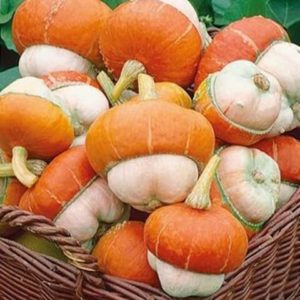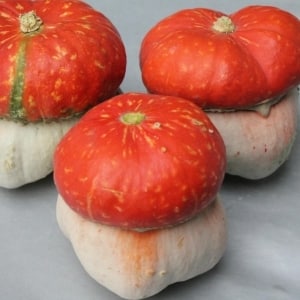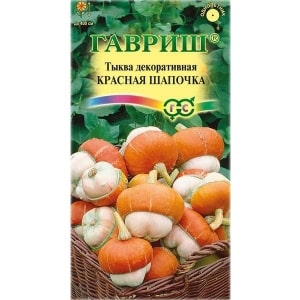What does the decorative turban-shaped pumpkin “Little Red Riding Hood” look like and why grow it?
The Red Riding Hood pumpkin variety is used for landscaping, and its bright fruits decorate hedges. However, these are not all options for using vegetables. In the article you will learn how to grow and care for Little Red Riding Hood, what is the secret of a good harvest and how else to use decorative pumpkin.
Description and characteristics of the variety
Outwardly, this variety of pumpkin from the turbanaceae family cannot be confused with any other. One of the features of the plant is its long tendrils, which make it possible to grow the crop on vertical supports.
Productivity
The Red Riding Hood variety is high-yielding. The plant is capable of producing more than 10-20 fruits from each bush weighing 2-5 kg.
Fruit characteristics
Externally, the vegetable looks like a mushroom with a red cap that resembles a turban. Below, the fruit has fairly clear edges with smoothed corners. The pulp is orange-yellow, bright. The taste is sweet, slightly reminiscent of melon, with a nutty aftertaste.
The weight of one decorative pumpkin “fungus” is about 2 kg, but you can grow pumpkins weighing 4-5 kg. The base of the fruit is light, cream-colored, sometimes with green inhomogeneous longitudinal stripes.
Pictured is the Little Red Riding Hood pumpkin:

Is it possible to eat decorative pumpkin?
Many, seeing a pumpkin in the form of a mushroom with a red cap, ask the question: “Is it possible to eat it?” Turban-shaped is a decorative, not a culinary variety. However, the young fruits of Little Red Riding Hood, unlike its bitter-tasting counterparts, are edible. It is eaten raw, stuffed, added to salads, stewed, fried and boiled.
Important! You can only eat vegetables with soft and thin skin. As the pumpkin grows, it becomes hard and unsuitable for food.
Pros and cons of the variety
The Red Riding Hood variety has a lot of advantages. These include:
- resistance to cold;

- ease of care;
- drought resistance;
- persistent immunity to a common disease - powdery mildew;
- Seed germination of the Red Riding Hood variety lasts 7 years.
What about the negatives? Here all experienced vegetable growers agree on one thing - the Red Riding Hood pumpkin has no flaws.
How to grow
They're imprisoning variety in spring, after frost. Seeds can be sown directly into the ground or seedlings can be prepared first. The difference will be in the timing of flowering and ripening - pumpkin seedlings will ripen and bear fruit faster.
It is recommended to plant the crop on the sunny side, next to some kind of support. For decorative purposes, gardeners sow it near the fence. Over time, the red cap begins to weave along the fence, forming a hedge.
Features of cultivation
To get a good harvest of decorative pumpkin, you should know the features of its cultivation. Little Red Riding Hood has quite a few of them:
- Vegetable crops are not picked. Transplantation begins in June. The planting scheme is as follows: the distance between plants is 0.3 m, the depth is no more than 0.3 m. The recommended distance between rows is 0.2 m.
- The turban-like culture prefers fertile soil with neutral acidity. Grows well and bears fruit on manure fertilizers. The rate of application of cow manure is 50 kg per 10 m².
- After planting, the plant is covered with film, creating a greenhouse effect. When the air warms up to 20 degrees, the film is removed. The vegetable begins to grow actively at a temperature of 30 degrees.
- It is necessary to shape the plant. Pinching begins when the lashes reach a length of 1 m.
- Turban-like grows poorly after sunflowers, watermelons, and potatoes. It is worth refusing to be adjacent to other large-fruited varieties. Red cap is best grown in complete isolation with artificial pollination.
Prevention of diseases and pests
Infection of a plant and the appearance of pests on it is easier to prevent.
For prevention purposes, it is recommended to carry out a number of agrotechnical measures:
- Follow the rules of crop rotation. Pumpkin crops are not planted in the same place more than once every 3-4 years.

- Carry out deep plowing with fresh manure.
- Maintain distance between plants. Do not thicken the plantings.
- Do not cultivate melons (zucchini, melons, cucumbers) nearby.
- Weed regularly. They contain fungal spores.
- Feed the pumpkin with complex mineral fertilizers (copper sulfate, boric acid with urea, potassium permanganate, zinc sulfate).
- Regularly inspect plantings for diseases and pests.
- Promptly remove infected plants and fruits.
- Plant residues after harvesting should be carefully removed from the field and burned.
Good care in most cases prevents plant diseases and insect damage. But if trouble does happen, you can’t hesitate.
To control pests, it is recommended to use herbal remedies or folk remedies that are harmless to humans. You should only resort to toxic chemicals in extreme cases.
Read also:
Why is the Marble pumpkin so popular among farmers?
Harvest and storage
Harvest before the first frost - in September-October. For gastronomic purposes, vegetables are cut unripe so that they do not have time to become tough. During the ripening process, the taste improves. However, The longer the fruits lie, the harder they will become. So, by spring they become so hard that they are suitable for making dishes.
At home, Little Red Riding Hood lies for about a year. To prevent pumpkins from spoiling for a long time, they are cut with a foot no shorter than 5 cm.
Advice! For planting next year, the seeds are stored in the fall. The ideal place for this is wet sand. Store seed in the refrigerator or on a closed balcony.
Reviews from gardeners
Most gardeners note in this variety its unpretentiousness in cultivation and versatility in use. There are no negative reviews about the variety. Judge for yourself:
Yuri: «This pumpkin is cold-resistant, resistant to powdery mildew, and drought-resistant. It is early ripening, sweet, productive. From one plant I collect up to 30 fruits weighing 3-5 kg. The plants are quite compact, the length of the vines does not exceed 3 m. Having reached a certain weight on the vine, the fruits then ripen safely in storage. The bulk of the fruits ripen in December-January when usually stored on the floor in the room. It is during this period that their taste is irresistible. The first fruits ripen much earlier.”
Irina: «Interestingly, turban-shaped pumpkins can be stored at home for more than a year. Seeds These pumpkins are healthy, with plenty of oil. Jam or candied fruits from turban-shaped pumpkins are transparent amber in color. When the pumpkin skin is still soft, you can stuff it with meat, vegetables and stew it in sour cream. But in a mature state they become inedible, with a thick crust.In spring, the pumpkin hardens, becoming suitable only for making vases.”
Faina: «I usually plant turban-shaped pumpkin “Little Red Riding Hood” with seeds. Although the pumpkin’s weight is small, it has tasty and sweet, bright orange pulp with a melon aroma. The fruits are rich in carotene. I like to bake pumpkin slices and make porridge from it.”
Conclusion
Increasingly, on the plots of summer residents you can find an unusual type of pumpkin, Little Red Riding Hood. This decorative variety has a number of advantages: high yield, long storage, resistance to cold and drought, bright taste.
The unpretentiousness of this crop will especially appeal to beginning gardeners. And despite the fact that it is more often used for decoration, there is also a place for it in gastronomy.
“Chalmovidnaya is a decorative, not a culinary variety”
Chiiiiiiiiiiight?! What kind of idiot wrote this? Victim of the Unified State Exam?